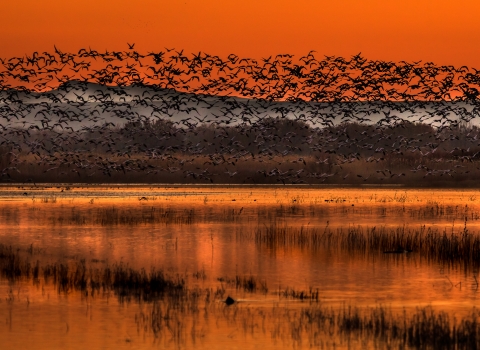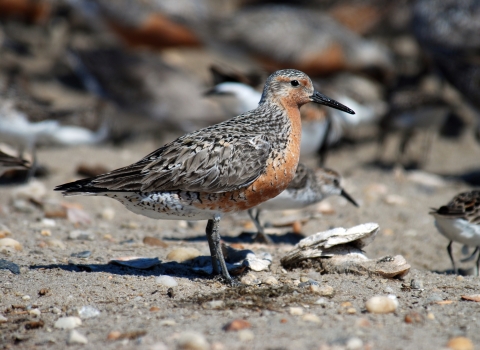It’s good to be shad !
Shad are a special and significant fish species in the Delaware River watershed, especially within the Brandywine River, which flows from Southern Pennsylvania through Northern Delaware. From their habitats in small tributaries, to their home out at sea, shad are a critical part of many ecosystems. But for a long time, things were bad for shad.
These fish are anadromous, meaning they migrate between freshwater the ocean where the shad spend most of their lives (reaching adulthood after the age of 15) before returning to freshwater to breed. However, shad have been cut off for centuries from historic spawning grounds by many dams along their historic waterway routes.
Conservation partners have been building momentum to remove dams throughout the watershed for years, but these projects can be technically and financially challenging.
Scientists, philanthropists, government agencies, and the public have all contributed to making a case for funding dam removals and other projects. Since 2017, Hunter Lott and his co-founder Jim Shanahan of Brandywine River Restoration Trust, has been helping lead the charge to restore the Brandywine River to its former glory. After all, this work doesn’t just improve the lives of fish, it will be beneficial to humans and other species too.
"I watch the eagles and I watch the osprey, and I fish for small mouth bass; I watch the beaver and the muskrat pack—this place is a treasure,” said Lott. “If you could restore it to its pre-colonial, free-flowing state, then you've done something that is worth the effort."
The Brandywine River travels from Pennsylvania to Delaware and has had as many as 100 dams at one time. Two of the ten remaining dams will be removed by 2023, and that’s where the Bipartisan Infrastructure Law plays a critical role in conservation. The law has provided significant funds through the U.S. Fish and Wildlife Service’s Delaware River Watershed Conservation Fund to, in part, take down several dams along the Delaware’s tributaries, including the Brandywine River. While the infrastructure law is helping to finish the job, it builds on years of work by people like Lott, who know and love this river.
Teamwork makes the dream work
It may be shocking to hear, but the first request to remove a dam on the Brandywine was in the 1700’s, by the Lenape people, one of the Indigenous Tribes who still call the area home. Blocking this river prevented a main source of food—shad—from reaching people who have lived in the area since time immemorial.
Finally, in 2019, the first dam, known as the West Street Dam, was taken out and the shad immediately returned and spawned! Within a year, the fingerling shad (very young fish, about the size of your finger) could be scooped up in nets by the hundreds.
Conservationists needed to show “proof of life” to prove a need for future dam removals—and boy did they! These resilient and steadfast fish—after 100 years without access—showed up like an old friend.
This historic and joyous moment was shared by many, including Hunter Lott. Nearing 80, Lott can often be heard saying he would like to see the Delaware portion of the Brandywine run free in his lifetime. With reserved optimism, he looks forward to the two removals slated for 2023. These two impasses in Delaware must be surmounted to make a run at the final dam upriver. Then the work will continue, as the Brandywine enters Pennsylvania. If Lott and all the partners can complete their end, the proverbial cork will be removed from the bottle and counterparts upriver can begin their push to free the river.
History
Historically, dams supplied water to power mills which supported many different industries. As time has worn on, and industry changed, many dams are no longer needed. But dam removal in the Northeast comes with its share of controversy.
Whether resistant to change or altering the historical component in the landscape, some view the mills and their associated dams as important reminders of the past. Paper, textile, flour-processing, and iron mills, which supported many different industries, dot the tributaries in the Delaware River watershed. The relics left behind are reminders of another time and have cultural significance, but their adjacent dams present hazards to people and wildlife. Mills are also associated with pollutants and contaminants in the water. They are expensive to maintain and upkeep. And while there are those who may see dam removal as unnecessary, there are many human-associated benefits, including flood prevention and positive economic impacts through outdoor recreation.
Health and resilience
Healthy rivers and their associated wetlands are vital, not just to fish like the shad, but a rich diversity of species like the majestic great blue heron and the critically endangered (and tiny) bog turtle—North America’s smallest turtle species. Humans benefit significantly from clean waters and healthy ecosystems, too! Whether you enjoy watching wildlife, angling, swimming or simply sipping a glass of water, you need access to clean water just like everything else that lives there.
Learn more about the conservation efforts happening in the Delaware River Watershed.








